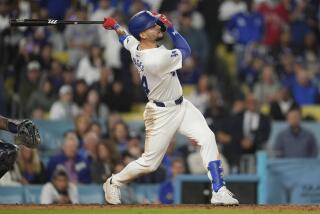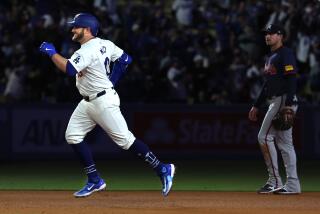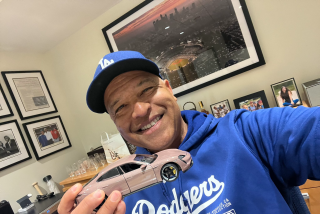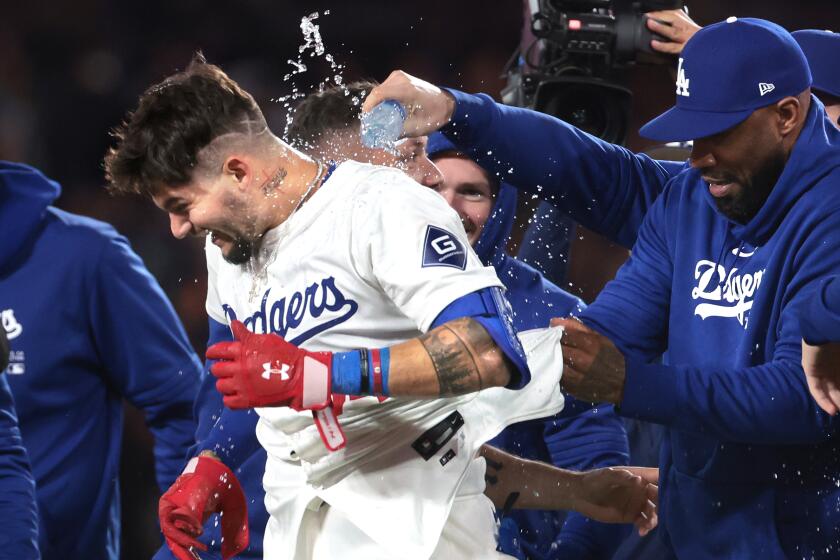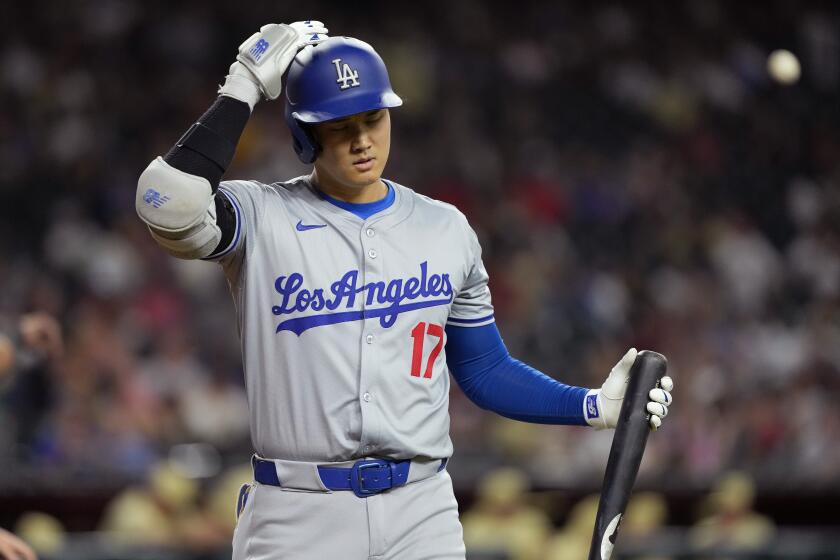Piazza Is a Hit, but Is He a Catch?
When you think of great Dodger teams of the past, you tend to think of pitchers--Koufax, Drysdale, Dazzy Vance, Whitlow Wyatt, Van Lingle Mungo.
But someone had to call for their pitches, set up those hitters, block that plate, direct the game.
The Dodgers were lucky. They had some of the game’s best behind the plate, too. Al Lopez caught Vance and Mungo. Mickey Owen was most famous for missing a third strike and a final out in the 1941 World Series, but he was one of the main reasons the Dodgers were even in it.
Roy Campanella was one of the players who made the team a dynasty. He caught Carl Erskine, Preacher Roe, Clem Labine. He taught Don Drysdale, not everything he knew but a lot of it.
When Campy’s career tragically ended before the Dodgers began playing in the West, they lucked out again. John Roseboro continued the tradition, a rock-solid, stylish student of the game who handled Drysdale, Sandy Koufax and Johnny Podres through the glory years. When he left, Steve Yeager was there, and when Yeager faded, Mike Scioscia stepped in. There was a fortuitous continuity.
A catcher is the glue that holds a team together. You can’t win without him. Lots of teams have made a World Series with a porous infield, a “hitless wonder” lineup, but almost none without an artisan behind the plate. Even the great Yankee teams that might not have been thought to need it had Bill Dickey. The Chicago Cubs haven’t won anything since Gabby Hartnett left.
The position is so important, the club doesn’t really require a hitter there. If a catcher can hit for average, or even homer sporadically, a manager is ecstatic. When a catcher can hit, it’s nice but it’s not necessary.
In the first place, the position is so mentally and physically demanding, it chips away at the concentration hitting requires. A right fielder can stand out there chewing bubble gum and plotting his next at-bat all night long. With a catcher, an at-bat is almost a respite.
Catching as a profession is a cross between scrubbing floors and sweeping chimneys. You’re masked and swaddled and shin-guarded until you’re almost claustrophobic back there. Your knees give out first. Roseboro was a 10-second sprinter--he used to steal home--when he came up. He qualified for the nickname “Shanty” by the time he put away the padding.
The game is a conspiracy against catchers. As if handling 95-m.p.h. fastballs and knucklers that came to the plate like hummingbirds weren’t enough, the game saw fit to introduce artificial surfaces that made throwing out baserunners like winning a lottery. Guys with Olympic speed and a 10-foot lead became the stealth bombers of the basepaths. You needed a guy with a lot of mental health back there.
So, the only thing the Dodgers can take comfort in this disastrous year-of-our-Lord is that they appear to have lucked out once more behind the plate.
Mike Piazza is not Gabby Hartnett or Roy Campanella yet. But he is a catcher who can hit.
They don’t have to be afraid the position will compromise his speed. He doesn’t have any. He stole only one base in his entire minor league career. Mike Piazza is not about to steal home.
It appears as if he won’t have to. At the close of the trip Sunday night, he was leading the team in batting with a robust .331, in home runs with six and he was working on a consecutive-hit streak of six. (He struck out in the second inning Monday night to end the streak.)
He hit 29 home runs one year in Bakersfield in only 117 games. He hit 16 last year at Albuquerque in 94 games and batted .341.
He can handle the pitches. Can he handle the pitchers?
Mike Piazza became a catcher for the most basic of reasons: It was his ticket to the major leagues. Drafted 62nd by the Dodgers, he was hardly in a posture to be demanding.
“I was desperate,” he says, grinning.
He was a first baseman at the time. But he looked up and saw Eric Karros, National League rookie of the year at the bag at age 25--Piazza is 24--and decided a career as Karros’ caddie was not what he had in mind.
Actually, Piazza was a golfer in college. But nothing happened to convince him that he was to become the next Jack Nicklaus. So, he settled for the traditional tools of ignorance and decided the best way to get to the big leagues was in a mask and protector. Behind the plate.
“I would say I was always able to hit the ball hard,” he says. “I had good bat speed, and I was a decent breaking-ball hitter. If catching was what was open, I was open to catching.”
The Dodgers now have to decide if that’s the best place to keep his bat in the lineup. Catching is a science. You can’t slug your way into it. You have to think your way into it. It’s the one position--shortstop may be another--that can tolerate a .240 hitter if his other mechanics are in order.
Mike Piazza is a Dodger and will be one for years to come. Whether he’s going to be in the line of succession to Lopez-Owen-Campanella-Roseboro-Scioscia depends not on the pitches he can hit, it’s the pitches he can call for and that the other guys can’t hit.
More to Read
Are you a true-blue fan?
Get our Dodgers Dugout newsletter for insights, news and much more.
You may occasionally receive promotional content from the Los Angeles Times.
